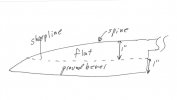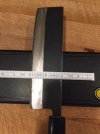- Joined
- Jun 3, 2019
- Messages
- 2,714
From your experience - is it generally more difficult to get a nice clean line on at flat grind at the transition from the grind to the blade flat at the spine for thin material as opposed to thicker material?? (I am not sure if this end-of-grind line has a name??) the videos giving tutorials on this show a nice clean line without a lot of fuss. I have tried this on three knives so far ... and all looks pretty good until I get down much closer to the end of the grind ... then things fall apart (fail to keep the line). On the other hand, I am working on pretty thin stock (0.08" O1), and am trying for a pretty low angle ... typically a grind distance of about .7" . Is this still just a matter or practice, or is it just plain more difficult with thin stock? (or easier with better equipment? - right now I am stuck using a Harbor Freight 1x30 belt sander - no flames please - am trying to work up the courage to order a real grinder.....)



